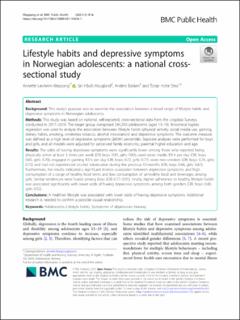| dc.description.abstract | Background: This study’s purpose was to examine the association between a broad range of lifestyle habits and depressive symptoms in Norwegian adolescents. Methods: This study was based on national, self-reported, cross-sectional data from the Ungdata Surveys, conducted in 2017–2019. The target group comprised 244,250 adolescents (ages 13–19). Binominal logistic regression was used to analyse the association between lifestyle habits (physical activity, social media use, gaming, dietary habits, smoking, smokeless tobacco, alcohol intoxication) and depressive symptoms. The outcome measure was defined as a high level of depressive symptoms (≥80th percentile). Separate analyses were performed for boys and girls, and all models were adjusted for perceived family economy, parental higher education and age. Results: The odds of having depressive symptoms were significantly lower among those who reported being physically active at least 3 times per week (OR; boys: 0.81, girls: 0.83), used social media ≤3 h per day (OR; boys: 0.65, girls: 0.70), engaged in gaming ≤3 h per day (OR; boys: 0.72, girls: 0.77), were non-smokers (OR; boys: 0.74, girls: 0.72) and had not experienced alcohol intoxication during the previous 12 months (OR; boys: 0.66, girls: 0.67). Furthermore, the results indicated a significant inverse association between depressive symptoms and high consumption of a range of healthy food items and low consumption of unhealthy food and beverages among girls. Similar tendencies were found among boys (OR; 0.77–0.91). Finally, higher adherence to healthy lifestyle habits was associated significantly with lower odds of having depressive symptoms among both genders (OR; boys: 0.40, girls: 0.52). Conclusions: A healthier lifestyle was associated with lower odds of having depressive symptoms. Additional research is needed to confirm a possible causal relationship. | en_US |

